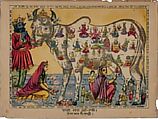Jagat Mata Go-Laxmi (World Mother Cow of Good Fortune)
Not on view
Reverence for the cow in India is ancient and complex, rooted in a pastoral age of early settlement in the subcontinent. Over time, reverence for the cow was given formal religious expression, including in the Bhavishya Purana. It is this text that has been given visual expression in this print and appears in the double-rule border of the image. The print shows Rani Dhanadevi performing a cow puja while Bharat Mata (Mother India) milks the cow. Standing near Bharat Mata are a Hindu, a Parsi, a Muslim, and a British boy each holding up their cups to receive the milk of Mother India. The divine cow has painted on her body images of Hindu gods and goddesses, in continuation of an ancient form of worship in which saffron-dyed hand-prints were applied to animals, usually intended for sacrifice, a practice even take up by early Buddhists with the application of palm-prints to stupas.
In the late 19th century, when nationalism was on the rise in pre-independent India, the personification of Bharat Mata (Mother India) as a maiden milking the holy cow, surrounded by people of different faiths enjoying the milk, created an image of national unity. This print embodies powerful sentiments supportive of Indian nationalism, a message immediately apparent to Indians of the day, if not readily grasped by their British administrators.
Due to rights restrictions, this image cannot be enlarged, viewed at full screen, or downloaded.

